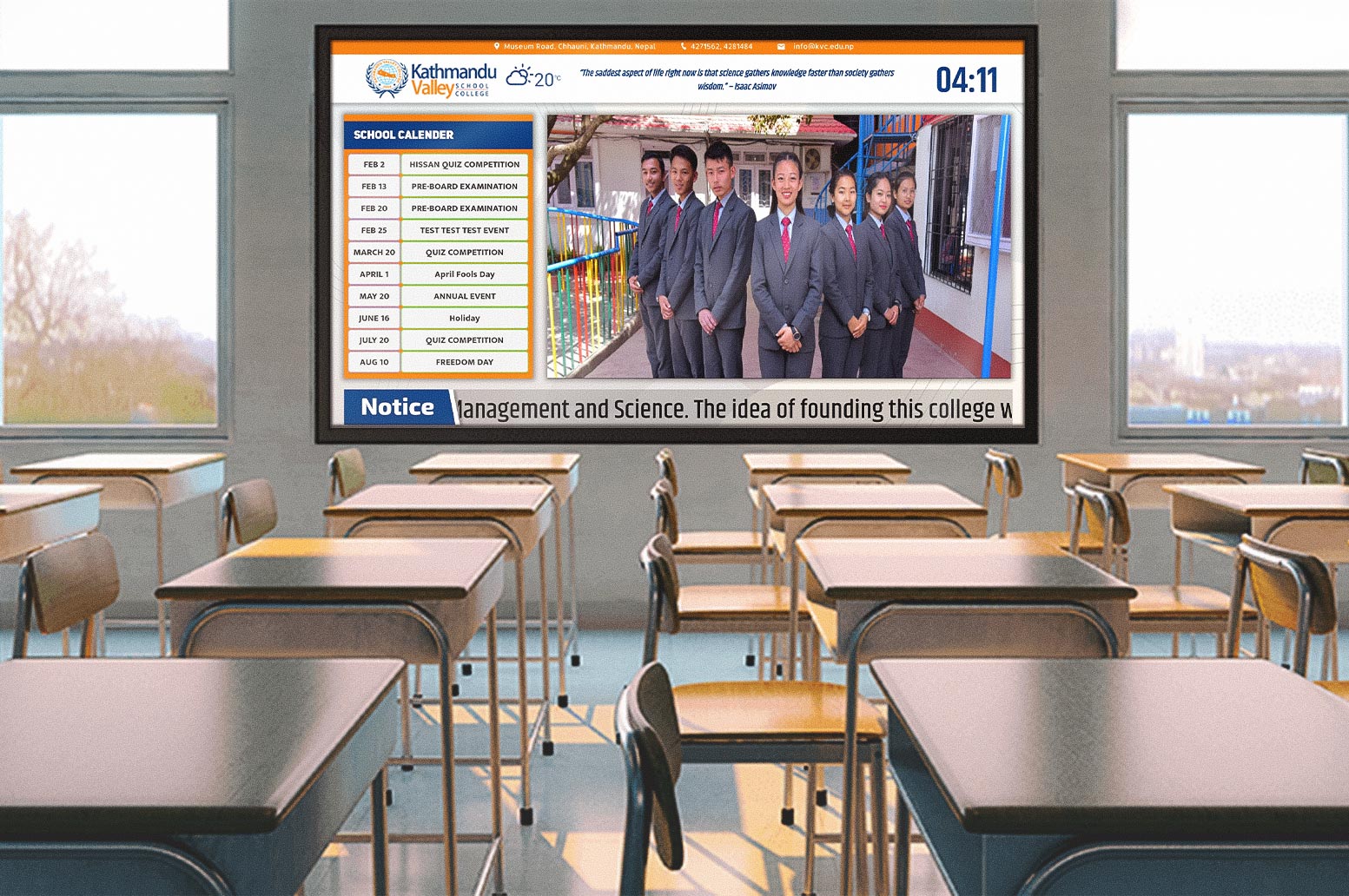Digital signage has become an increasingly popular and effective tool for communication in various sectors, including education. With advancements in technology, schools and colleges in Nepal are now embracing digital signage to enhance communication, engage students, and streamline operations. This article will explore the benefits, use cases, implementation, best practices, and real-life examples of digital signage for schools and colleges in Nepal.
| Introduction | – What is digital signage? – Why is it important for schools and colleges in Nepal? |
| Benefits of Digital Signage | – Enhanced communication – Engaging and informative content – Cost-effectiveness – Time-saving |
| Use Cases for Digital Signage in Schools and Colleges | – Announcements and notifications – Event promotion – Emergency alerts – Way-finding and navigation |
| Implementing Digital Signage | – Hardware requirements – Software options – Content creation and management – Installation and maintenance |
| Best Practices for Digital Signage | – Placement and visibility – Eye-catching content – Regular updates and maintenance – Monitoring and evaluation |
| Case Studies | – Kathmandu Valley School’s successful implementation of digital signage – Godawari College’s innovative use of digital signage |
| Conclusion | – Recap of benefits – Encouragement for schools and colleges to embrace digital signage |
Introduction
What is digital signage?
Digital signage refers to using digital displays, such as LCD screens, video walls, and interactive touch screens, to convey information, messages, and visuals. It is a versatile medium that allows dynamic content delivery, including text, images, videos, and animations, to capture and hold the viewers’ attention.
Why is it important for schools and colleges in Nepal?
In the digital age, traditional methods of communication, such as notice boards and printed flyers, are no longer sufficient to meet the growing demands of educational institutions. Digital signage provides a modern and efficient solution to disseminate information, engage students, and create a vibrant learning environment. Let’s explore the benefits of digital signage in more detail.
Benefits of Digital Signage
Enhanced communication
Digital signage enables schools and colleges to communicate effectively with their students, faculty, and staff. Important announcements, reminders, and event details can be displayed in real-time, ensuring everyone stays informed. Whether schedule changes, exam notifications, or extracurricular activities, digital signage ensures that information reaches the intended audience quickly and efficiently.
Engaging and informative content
With digital signage, educational institutions can present information visually appealing and engagingly. Instead of static posters and signs, dynamic content can be displayed to capture students’ attention. Videos, animations, and interactive elements can be incorporated to make learning more enjoyable and memorable. Whether showcasing student achievements, displaying educational videos, or promoting upcoming events, digital signage creates an immersive learning experience.
Cost-effectiveness
Contrary to the perception that digital signage is an expensive investment, it can actually be a cost-effective solution in the long run. While there may be initial setup costs, digital signage eliminates the recurring expenses of printing and distributing paper-based materials. Updates and changes to the content can be easily done remotely, reducing the need for manual labor and minimizing wastage of resources.
Time-saving
Traditional methods of communication often require significant time and effort. With digital signage, information can be updated and distributed quickly and effortlessly. Instead of manually replacing posters or distributing paper handouts, administrators can remotely manage and control the content displayed on digital signage screens, saving valuable time and resources.
Use Cases for Digital Signage in Schools and Colleges
Digital signage offers a wide range of applications in educational settings. Let’s explore some of the key use cases:
Announcements and notifications
Digital signage can be used to display important announcements, such as school closures, exam schedules, or upcoming deadlines. Notifications can be updated in real-time, ensuring that students, faculty, and staff are always aware of the latest information.
Event promotion
Whether it’s a guest lecture, a cultural event, or a sports competition, digital signage can be used to promote and create awareness about upcoming events. Eye-catching visuals and engaging content can generate excitement and encourage participation among students.
Emergency alerts
In case of emergencies or critical situations, digital signage can play a vital role in communicating important instructions and safety protocols. Instant alerts can be displayed across screens, guiding students and staff on appropriate actions.
Wayfinding and navigation
Large campuses can often be confusing to navigate, especially for new students or visitors. Digital signage can provide interactive maps and directions to help individuals find their way around. This simplifies navigation, reduces confusion, and enhances the overall experience of students and visitors.
Implementing Digital Signage
To implement digital signage in schools and colleges, certain key considerations need to be taken into account.
Hardware requirements
The first step is to identify the hardware requirements based on the specific needs of the institution. This includes choosing the appropriate display screens, media players, mounting options, and connectivity options. Factors such as screen size, resolution, and durability should be considered to ensure optimal performance.
Software options
There are various software solutions available for managing digital signage content. These platforms offer features such as content scheduling, remote content management, and real-time updates. Institutions should evaluate different software options based on their requirements and choose a user-friendly and reliable solution.
Content creation and management
Creating visually appealing and engaging content is essential for the success of digital signage. Institutions can leverage the skills of graphic designers, video editors, and content creators to develop compelling visuals and messages. A content management system should be established to organize, schedule, and update the content regularly.
Installation and maintenance
Once the hardware and software are in place, installation and maintenance should be carried out efficiently. Screens should be strategically placed in high-traffic areas where they can grab maximum attention. Regular maintenance, including software updates and screen cleaning, ensures the smooth functioning of the digital signage system.
Best Practices for Digital Signage
To make the most of digital signage, here are some best practices to consider:
Placement and visibility
Strategic placement of digital signage screens is crucial for maximum visibility and impact. High-traffic areas such as entrance halls, cafeterias, and common areas are ideal locations. The screens should be positioned at eye level and free from obstructions to ensure easy viewing.
Eye-catching content
Captivating content is essential to grab the attention of students and create an impact. Using vibrant colors, bold fonts, and high-quality visuals can make the content visually appealing and engaging. Incorporating interactive elements and multimedia can further enhance the experience.
Regular updates and maintenance
Digital signage content should be regularly updated to keep it fresh and relevant. Outdated or irrelevant information can lead to decreased engagement. Additionally, regular maintenance of the hardware and software is crucial to ensure optimal performance and prevent technical issues.
Monitoring and evaluation
It is important to monitor the effectiveness of the digital signage system and evaluate its impact. Collecting feedback from students, faculty, and staff can provide valuable insights for improvement. Tracking metrics such as viewership, engagement, and click-through rates can help measure the success of different content strategies.
Case Studies
Let’s take a look at a couple of case studies that highlight successful implementations of digital signage in schools and colleges.
Kathmandu Valley School’s successful implementation of digital signage
Kathmandu Valley School in Nepal implemented digital signage throughout its school to enhance communication and engage students. By displaying announcements, event promotions, and achievements on digital screens, the school saw increased student participation and improved overall communication between students, faculty, and parents.
Godawari College’s innovative use of digital signage
Godawari College integrated digital signage with its way-finding system to provide interactive maps and directions to students and visitors. The college saw a significant reduction in confusion and improved navigation efficiency, making it easier for individuals to find their way around the campus.
Conclusion
Digital signage has emerged as a powerful communication tool for schools and colleges in Nepal. With its ability to enhance communication, engage students, and streamline operations, digital signage offers numerous benefits. By embracing digital signage, educational institutions can create a dynamic and vibrant learning environment that fosters effective communication and enriches the overall educational experience.
FAQs (Frequently Asked Questions)
1. Is digital signage expensive to implement in schools and colleges?
While there may be initial setup costs, digital signage can be a cost-effective solution in the long run. It eliminates recurring expenses associated with printing and distributing paper-based materials.
2. Can digital signage be used for emergency alerts?
Yes, digital signage can play a vital role in communicating important instructions and safety protocols during emergencies or critical situations.
3. How often should digital signage content be updated?
Digital signage content should be regularly updated to keep it fresh and relevant. Outdated information can lead to decreased engagement.
4. What are the best locations to place digital signage screens in educational institutions?
High-traffic areas such as entrance halls, cafeterias, and common areas are ideal locations for digital signage screens.
5. How can the effectiveness of digital signage be measured?
Metrics such as viewership, engagement, and click-through rates can be tracked to measure the success and effectiveness of digital signage content strategies.


